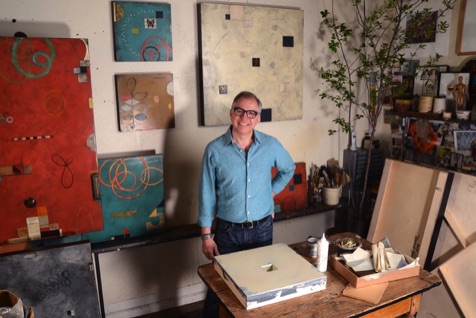I seek a way to give my ideas a format and my symbols a place. It is this desire to reconcile the structured and the random - order and disorder - that results in compositions where the individual parts coalesce into a harmonious whole.
Using the garden as metaphor, my work focuses on the transitional and transformative phases that I refer to as, “the in-between seasons” - the period when a garden or landscape is largely in flux. Exploring the issues of chaos vs. order and creation vs. destruction or the cyclical aspects of nature is what intrigues me. I find a great deal of inspiration during the changing of seasons, when the landscape influences and informs my paintings through gentle color and compositional shifts. Utilizing both representational and abstractive techniques my goal is to portray the importance of the garden as a fundamental pivot where nature and culture convene and transform one another.
Organic elements and references to botanical forms run through my work in both the traditional and abstracted manner. Similarly, strong graphical references also play a crucial role and ground the compositions in a way that adds order to the random elements to reflect nature’s inherent geometry. For me, it’s a matter of pinning down these elusive shapes, forms and symbols to a basic structure, utilizing the grid as a framework where I can organize the elements of a painting. Just as an airplane passenger can look down at the earth and see how an organic landscape is broken into geometric shapes,
Artist Statement
Excerpt from the book: Colorado Abstract: Paintings and Sculpture by Michael Paglia and Mary Voelz Chandler, 2008
Finding order in disorder is a key element in paintings and collages by Don Quade, who brings to his
work a background and a sensibility that makes the intersection of rationalism and abstraction an
almost reflexive act. His symbols and forms find a place on a canvas through a talent at organization
that is fluid enough to leave room for the spontaneous gesture and what he calls the happy accident.
Born in El Paso, Texas in 1963, Quade moved to Colorado as a teenager. As a child he knew he
wanted to become an artist, and went on to earn a Bachelor of Fine Arts degree from Colorado State
University with a minor in art history. He then began working as a graphic designer.
His skill and devotion to good design informs his work, as does a less readily apparent entity. For
as Quade believes that thoughtful design should be a given, so does he find inspiration in nature,
especially in the changes of seasons and humankind’s most addictive effort to shape the environment:
the garden. And as someone who is steeped in the character of the Southwest, Quade is not
just influenced by the sense of openness and the impact of the region’s brilliant light. He knows the
difficulty of taming and reclaiming land, and also how difficult it is to nurture living things through
erratic and harsh seasons.
This cyclical aspect of nature informs his work, since he is interested in what he calls the in-between
seasons, the period when a garden or the landscape at large is in flux. Here order is interrupted,
growth deteriorates and life comes to an end, but with the knowledge that time will bring it back.
Vegetal elements and references to natural forms run through his work, though in an abstracted
manner.
That’s where his interest in design comes in, since a desire to make sense of random elements through
nature’s inherent geometry serves as a filter for his world. It’s a matter of pinning down elusive shapes,
forms and symbols to a basic structure. In some cases, the answer takes on the character of a grid,
a framework in which Quade can organize the elements of a painting. Just as an airplane passenger
can look down at the earth and see how an organic landscape is broken into geometric shapes,
Quade seeks a way to give ideas a format and symbols a place in his vocabulary.
Over the years, Quade’s palette has followed a similar pattern, in that it tracks the evolution of the
seasons. Though some of his early work was darker, his paintings now tend toward a lighter ground,
with brighter and bolder colors that stand out for their affinity for the natural world. But it is this desire
to reconcile the structured and the random—order and disorder—that results in compositions where
the parts coalesce into a harmonious whole.
